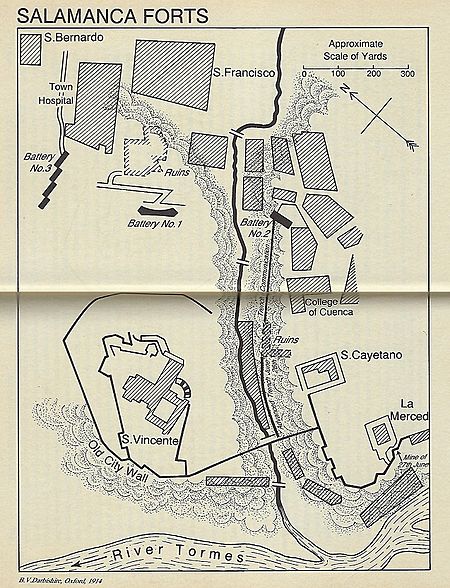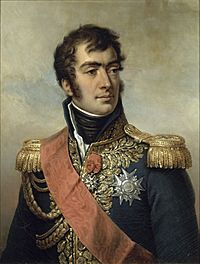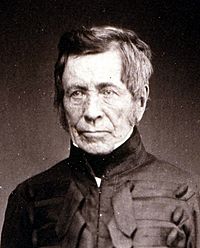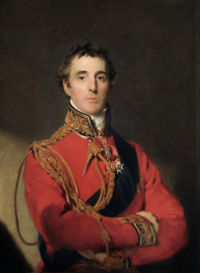Siege of the Salamanca forts facts for kids
Quick facts for kids Siege of the Salamanca forts |
|||||||
|---|---|---|---|---|---|---|---|
| Part of the Peninsular War | |||||||
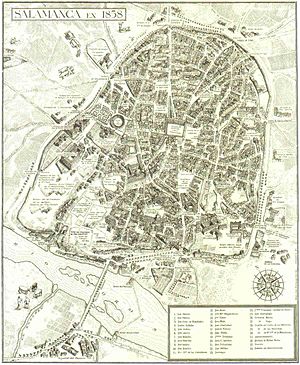 1858 map of Salamanca shows empty spaces in the southwest corner of the city where the forts were located |
|||||||
|
|||||||
| Belligerents | |||||||
| Commanders and leaders | |||||||
| Strength | |||||||
| 40,800 36 guns |
48,000 4 guns 6 howitzers |
||||||
| Casualties and losses | |||||||
| 800 killed, wounded or captured 36 guns lost |
99 killed 331 wounded |
||||||
The Siege of the Salamanca Forts happened from June 17 to June 27, 1812. It was a fight during the Peninsular War. A small French army of about 800 soldiers defended three strong forts in the city of Salamanca, Spain. They were led by Lieutenant Colonel Duchemin. A much larger Allied army, about 48,000 soldiers, attacked them. This Allied army was led by Lord Wellington.
The main French commander, Marshal Auguste de Marmont, tried to help the forts with his army of 40,000 men. But he could not reach them. The Allies had trouble because they didn't bring enough big guns or ammunition. This made the siege last longer. The French soldiers bravely fought off an attack on June 23. But they finally gave up four days later. This happened after the Allied cannons broke through one fort and set another on fire. Marshal Marmont thought Lord Wellington was only good at defending. This wrong idea helped lead to Marmont's defeat at the Battle of Salamanca a month later.
Contents
Why the Siege Happened
The War in Spain
In early 1812, the Allied army, led by Lord Wellington, won two important battles. They captured Ciudad Rodrigo in January and Badajoz in April. These wins gave the Allies a big advantage in Spain. At the same time, the French leader, Emperor Napoleon, started focusing on his plans to invade Russia. He pulled many of his best soldiers out of Spain. This made the French army in Spain weaker.
Napoleon ordered his brother, King Joseph Bonaparte, to take charge of the French armies in Spain. But in reality, the French marshals in different parts of Spain still acted on their own. This made it hard for them to work together.
Wellington's Plan
Lord Wellington decided to attack Marshal Marmont's French army in western Spain. Wellington had about 48,000 soldiers. He also sent another general, Rowland Hill, with 18,000 soldiers to watch the city of Badajoz. To stop other French armies from helping Marmont, Wellington asked Spanish forces to bother the French in the south. He also asked the British navy to attack the northern coast of Spain.
Marmont's army had about 52,000 soldiers. But only 35,000 were ready to fight right away. They were spread out trying to find food. King Joseph and his chief of staff, Marshal Jean-Baptiste Jourdan, had 18,000 men near Madrid. Joseph told Marmont and another marshal, Soult, to work together if Wellington attacked. But Soult refused to help.
Armies on the Move
On June 13, Wellington's army crossed a river and began to march towards Salamanca. They moved in three groups. On June 16, the Allied cavalry chased away some French horsemen near Salamanca.
When Marmont heard about Wellington's attack, he quickly gathered his army. He had about 36,000 foot soldiers, 2,800 horsemen, and 80 cannons. Marmont also called for more soldiers from Asturias, but they would take almost three weeks to arrive. Wellington's army had 28,000 British, 17,000 Portuguese, and 3,000 Spanish soldiers. In total, he had 48,000 men. For the first time, the Allies had more cavalry (horse soldiers) than the French. Both commanders wanted to fight a big battle. But Marmont wanted to wait until his extra soldiers arrived.
The Siege Begins
Attacking the Forts
On June 17, Wellington's army surrounded Salamanca. The people of Salamanca were very happy to see the French leave. Only the British 6th Division entered the city to attack the forts. Wellington set up his headquarters in the city. To get ready for defense, the French had torn down parts of the old University. They used the stones to make the forts stronger.
Wellington thought the forts were just old convents that were not very strong. Because of this, the Allies only brought four large cannons. Each cannon had only 100 cannonballs. But the three convents were actually made very strong. The French had doubled their walls with stone, wood, and earth. They blocked windows and built defenses around them.
The largest fort, San Vincente, had 30 cannons. It was at the southwest corner of the old city wall. San Cayetano was southeast of San Vincente and had four cannons. La Merced was south of San Cayetano and had two cannons. These forts were built to help each other. If one fort was attacked, the others could fire at the attackers.
The French soldiers defending the forts were about 800 men. They had 36 cannons. The British 6th Division was in charge of the attack.
Early Bombardment
The Allies started digging a place for their cannons about 250 yards north of San Vincente. This was on the night of June 17. The soldiers were not used to digging siege trenches. The French fired cannons and muskets at them all night. The trench was not deep enough, so the workers had to hide. The next night, French defenders found a group of Allied scouts and wounded some of them. The Allies added 300 sharpshooters to help stop the French fire.
By the morning of June 19, the first cannon spot was ready. The four large cannons and three howitzers (another type of cannon) began to fire. They caused some damage to San Vincente. Two more cannon spots were started. Two howitzers were moved to one of these spots. But the French fired back so strongly that 20 gunners were hurt that day.
On June 20, more howitzers arrived from a Portuguese fort. Two of the large cannons were moved to a new spot. Their fire hit San Vincente's roof, killing some French defenders. But Wellington saw that his cannons were running out of ammunition. He asked for more supplies to be sent. The cannon fire was stopped.
French Attempts to Help
Marmont's Advance
After gathering his army, Marshal Marmont marched towards Salamanca on June 20. He pushed back the Allied cavalry. Wellington placed his army on some high ground near Salamanca. He hoped Marmont would attack him there. The two brigades of the 6th Division continued to surround the forts. Marmont's troops attacked a village called Moriscos. The British soldiers fought them off three times. But Wellington pulled his troops back that night.
Wellington expected Marmont to attack on the morning of June 21. But Marmont did not attack because some of his divisions arrived late. Wellington could have attacked Marmont that morning because the French were outnumbered. But Wellington wanted to win a defensive battle, like he had done before. On June 22, Wellington realized Marmont was not going to attack. Wellington ordered some British soldiers to drive the French from a small hill near Moriscos. This was done with only a few British soldiers killed or wounded. That night, Marmont's army moved back about 6 miles. On June 23, Wellington sent more troops back to Salamanca to continue the siege.
The Final Attack
The Failed Assault
On June 23, the Allies started attacking the forts again. But they still had very little ammunition. The large cannons only had 60 shots left, and the howitzers had only 160 shells. The engineers decided to ignore San Vincente because it was too strong. They focused on San Cayetano. One of the large cannons was moved to fire at a weak spot in San Cayetano. After firing all morning, the cannons ran out of ammunition in the afternoon. San Cayetano was damaged, but its walls were not broken. Even so, Wellington ordered an attack for 10 pm that night.
The attacking force was about 300 to 400 men. Since there was no hole in the wall, they carried 20 ladders to climb over the defenses. The soldiers felt that the attack would be very hard. As soon as they ran out from cover, they were hit by heavy cannon and musket fire from both San Cayetano and San Vincente. Soldiers were hurt right away. Only two ladders were put up, but no one dared to climb them. It was clear the attack would not work. The attack failed. Six officers and 120 men were killed or wounded. The British asked for a break to get their dead and wounded, but the French said no.
More Bombardment
On the morning of June 24, there was a thick fog. When the fog cleared, Wellington saw French soldiers crossing the river. He sent two divisions and cavalry to stop them. The French advanced but then turned back. They did not attack. Wellington's troops returned to their positions. On June 25, nothing happened. On this day, Allied soldiers dug a trench that cut off San Vincente from the other two forts.
On the morning of June 26, the ammunition convoy finally arrived! The artillerists moved all four large cannons to fire at San Cayetano. Four howitzers were placed to fire hot shot into the roof of San Vincente. The firing began at 3 pm and continued all night. Many fires started in San Vincente's roof and tower, but the French put them out. The French had used a lot of wood to strengthen the fort, which now provided fuel for the fires.
After four more hours of firing on the morning of June 27, the large cannons broke a hole in San Cayetano's walls. A new fire started in San Vincente. It lit up the main store of wood and threatened to blow up the gunpowder. The French had been firing back strongly, but now their fire started to slow down. Wellington ordered San Cayetano to be attacked.
The attacking soldiers gathered in a ditch below San Cayetano. Just as they were about to charge, a white flag appeared. The French commander asked for a break to talk. Wellington demanded they surrender in five minutes. The French officer tried to argue, but the soldiers rushed the fort. A few shots were fired, wounding six attackers. Then, the French soldiers in San Cayetano gave up. By this time, the fire in San Vincente was huge. A white flag appeared there too. The French commander asked for a three-hour break. But Wellington repeated his demand: surrender in five minutes or face an attack. The French tried to delay, but the Allied soldiers entered the fort. There was no resistance, and the French flag was taken down. The third fort, La Merced, also surrendered.
What Happened Next
The British lost 5 officers and 94 men killed, and 29 officers and 302 men wounded. The French lost 3 officers and 40 men killed, 11 officers and 140 men wounded. Almost 600 French soldiers were captured. The Allies also captured 36 cannons and a lot of gunpowder and clothing. The Allies then destroyed the three forts.
On June 26, Marshal Marmont learned that he would not be getting more soldiers. The British navy was attacking the coast, and Spanish fighters were causing trouble in the north. Marmont could not spare any men. When he heard that the forts had fallen, Marmont began to retreat north. In early July, Marmont was joined by another division of soldiers. This made his army about the same size as Wellington's.
Perhaps the most important thing that came from this siege was Marmont's wrong idea about Wellington. Because Wellington had mostly stayed on the defensive during the siege, Marmont thought he could take risks with his opponent. This may have led to Marmont's big defeat at the Battle of Salamanca on July 22, 1812.
Images for kids
See also
 In Spanish: Sitio de los fuertes de Salamanca para niños
In Spanish: Sitio de los fuertes de Salamanca para niños


